Shrimply Explained is currently undergoing renovations. Please don't buy anything yet. Thank you!
Dwarf shrimp such as Neocaridina, Caridina, ghost, and Amano shrimp, are gaining popularity in the aquarium hobby as people realize how great they are. It's just unbiased science. One reason for their popularity is because these species (excluding Amano shrimp) are quite easy to breed, assuming you have at least one male and female. These species have distinct physical differences between sexes - a phenomenon known as sexual dimorphism. Knowing what these differences are helps to pick out a good mix of shrimp from your store or check that you got a good mix in your online order. The rest of this guide covers the visible differences between male and female dwarf shrimp, along with how reliable each difference is and why they evolved this way. We've also created a handy Shrimp Sex Determination infographic that summarizes information in this article.
Please note that sexual dimorphisms become most obvious once shrimp reach sexual maturity (roughly 75 days after birth). Stores often sell shrimp before they reach this point, so it may be tough to tell the sex of your shrimp until they get older.
Other Shrimp Content
We have a lot of content coming soon. Please follow us on social media and subscribe to our newsletter for updates and useful shrimp care tips!
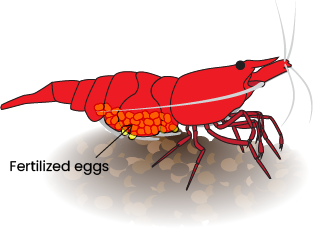
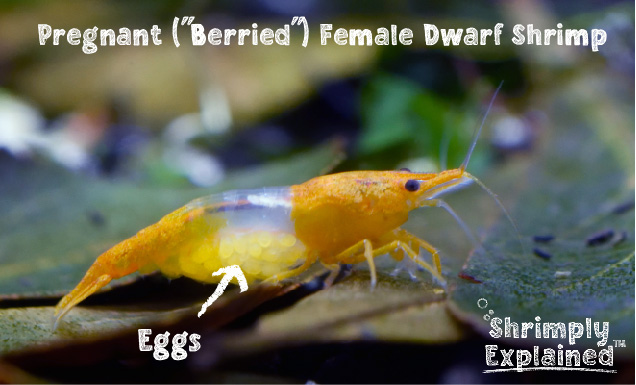
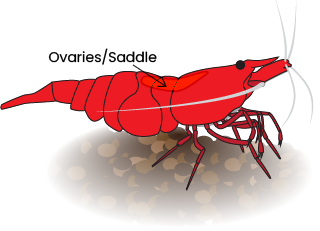
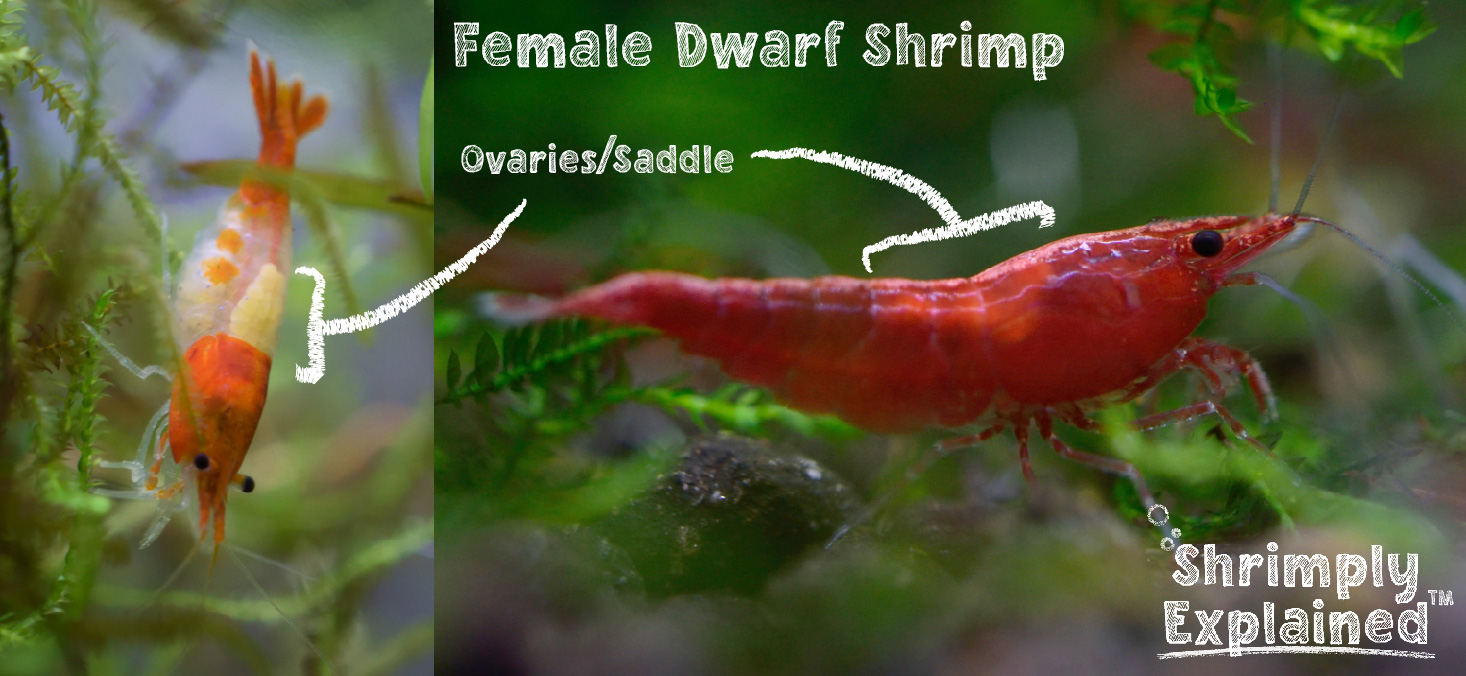
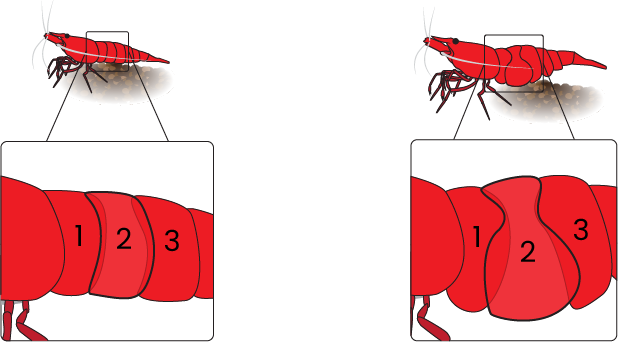
For female shrimp, the second abdominal segment has a noticeably wider base than the male’s. The difference develops during their teenage years and becomes more distinct as they age. Seeing the difference requires a keen eye--especially when the shell is transparent--but is a reliable differentiator even when eggs aren’t visible.
Evolutionary Purpose: The expansion of the second segment creates room for the female to carry more eggs, resulting in more offspring with the same trait.


One of the most commonly noted differences between male and female dwarf shrimp is the curve of their abdomen. As they mature, females develop a more rounded undercarriage due to the larger second abdominal segment, whereas male abdomens remain relatively straight. This difference becomes even more pronounced after a female has been berried at least once because her abdomen expands outward to carry more eggs. This is part of why females mate after molting, as that is when their shell is most flexible to expand with the number of eggs.
We could combine this difference with the section on abdominal segments, but it is a slightly different characteristic to look for. We find that the second abdominal segment also is more reliable at a younger age than body shape is, at least until females have their first offspring. After that, abdomen shape is often the most obvious indicator.
Evolutionary Purpose: A larger abdomen allows females to hold more eggs and therefore have more offspring to pass on the trait. Males, on the other hand, have no need for a larger abdomen.



Healthy female dwarf shrimp are typically larger than males. For example, female Neocaridina reach up to approximately 1.5 inches (3.8 cm) while males tend to be less than 1.0 inches (2.54 cm).
The problem with this method is that you don’t always know the age of the shrimp you’re looking at, though, so this is an unreliable sex determination method unless you can compare a shrimp to one of the same age in your tank. Often, evidence of eggs or a saddle are applicable earlier and more reliably. Size also depends heavily on growth in a healthy environment, which is why it is one of the main factors judged in shrimp shows/competitions (Yes, those are a thing!).
Evolutionary Explanation: The size difference between males and females is often seen in species where the females produce many offspring at once. It is theorized that this phenomenon is seen because larger females tend to be able to produce more eggs, which in turn leads to more offspring that mate and pass on the larger female genes. Females being larger than males is a common characteristic among insects (which shrimp technically are)

Female dwarf shrimp tend to have more color coverage and brighter/more solid colors. We say “tends to” because some males are just as colorful as females, especially if you have a population of higher-grade shrimp. As a result, this difference is only semi-reliable to sex colorful species like Neocaridina and Caridina. An additional problem is that shrimp may lose color under stress, making it more difficult to identify them. It’s best to use color in combination with other differences in this article to identify sex reliably.
As a side note, this color difference is a common reason why shrimp keepers may accidentally pick out all females from their local fish store. They look the biggest and most attractive, so unknowing shrimp keepers pick them out of the tank and wind up disappointed when their shrimp don’t breed.
Evolutionary Explanation: We was unable to find any research that provided a hypothesis for the color difference between male and female shrimp. In other species, males are typically brighter than females because females spend the most resources on caring for offspring, so they want the best mate possible. Color intensity is a sign of good health, so females choose the most colorful males.
There are a few examples of species where females may be brighter than males. This typically happens when the roles are reversed, with the males spending resources caring for their offspring. Since female shrimp are the ones caring for the eggs, there is not a clear explanation for the color difference.
A few articles and breeders state that males have longer antennae than females. We’ve tried observing known male and female shrimp in our tanks to compare antennae size but could not see any difference. We also could not find any research that supported the claim, although there is a paper stating that researchers found significantly more aesthetascs (tiny hairs that sense the directions of chemicals) on male antennae. So, if you want to get your electron microscope out and look at the number of aesthetascs on juvenile shrimp antennae, then you may reliably determine their sex. That’s very stressful for them though so we don’t recommend it…
Evolutionary Purpose: Researchers in the paper propose that male antennae evolved to have more sensing hairs because it allows them to pick up the pheromones of females quickly and mate more, thereby passing on their genes to more offspring.
Just ask them - preferably over a fine dinner of bloodworms and moss. Sit them down and ask them straight-up about their sex. It’s nerve-wracking for first-timers, but you just gotta do it.
Here’s a script I wrote in case you find yourself floundering during the meal or have a particularly stubborn shrimp.
First, commence small talk. “So how’s the weather?”
Shrimp: “Oh you know, wet and sunny. Pretty much the same every—“
Quickly interrupt the small talk to show dominance. “Enough small talk! Are you male or female?”

“Oh, uh…” The shrimp waves around its antennae nervously. “Pretty much, the same…”
You push your chair back.
“every day…”
Climb onto the table and crawl toward them, being sure to send the plates flying as you go.
“As I was saying…”
Look ‘em right in the eye and let ‘em sweat for a second before repeating your question. “Male… or female…?” Be sure to do the pause for dramatic effect. As shown in the scientific illustration below, the shrimp may initially be shocked and unable to communicate clearly. Don’t worry though, they’ll recover and tell you.
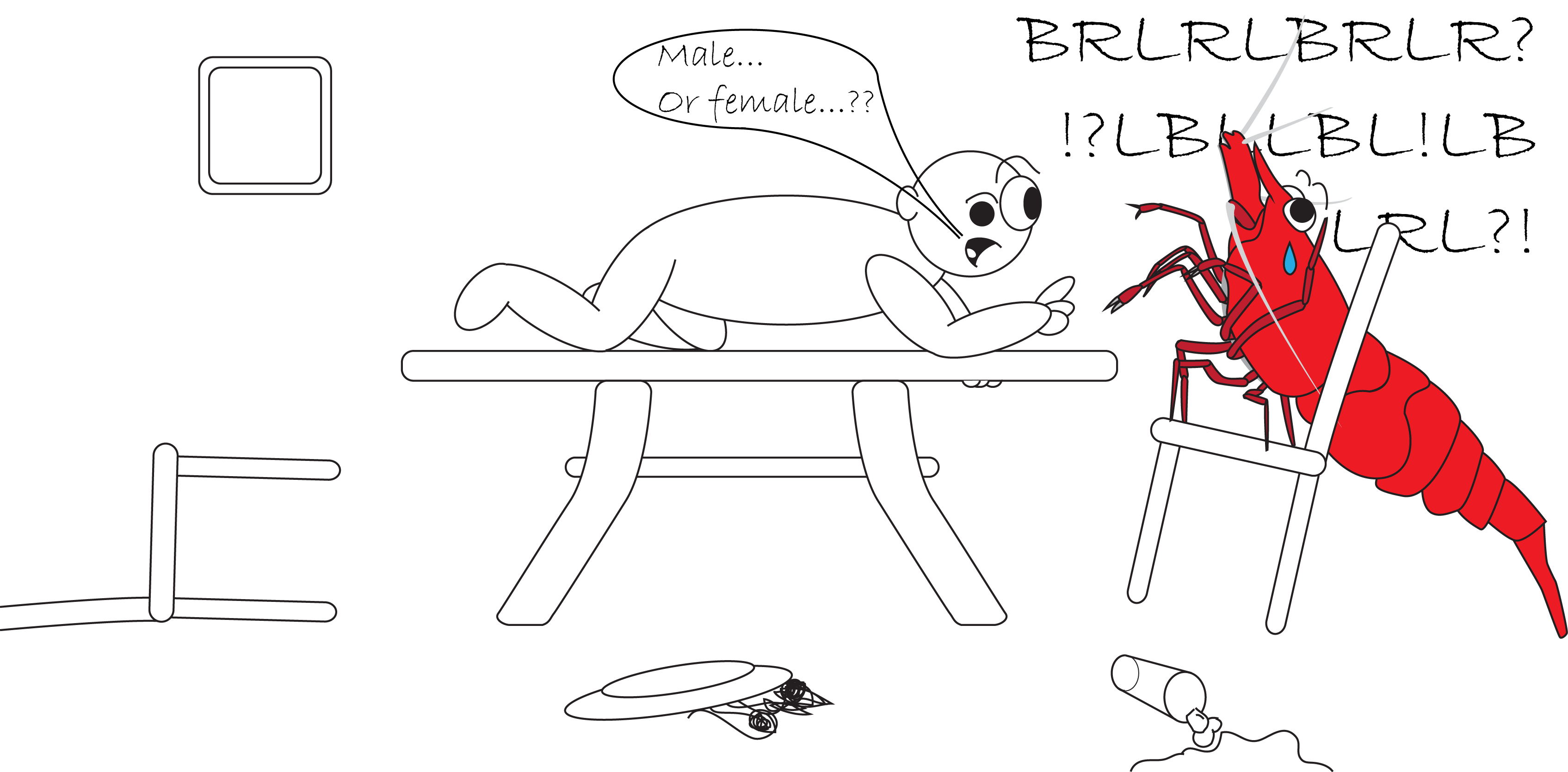
The following anatomical differences are incredibly difficult to identify without a microscope, so these are more just for educational purposes.
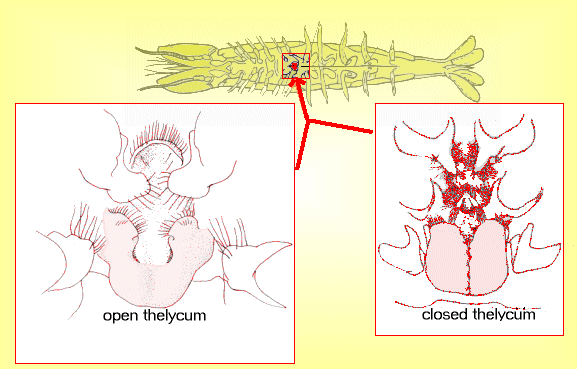 Shrimp thelycum - Image Source
Shrimp thelycum - Image SourceThe thelycum is an opening between a female’s fifth pair of walking legs and is where the male delivers their sperm during mating. It is very small and difficult to see so is not a well-known body part or useful for determining sex.
Some related shrimp species can store sperm for long periods of time in their thelycum, but this does not seem to be the case with most dwarf shrimp species.
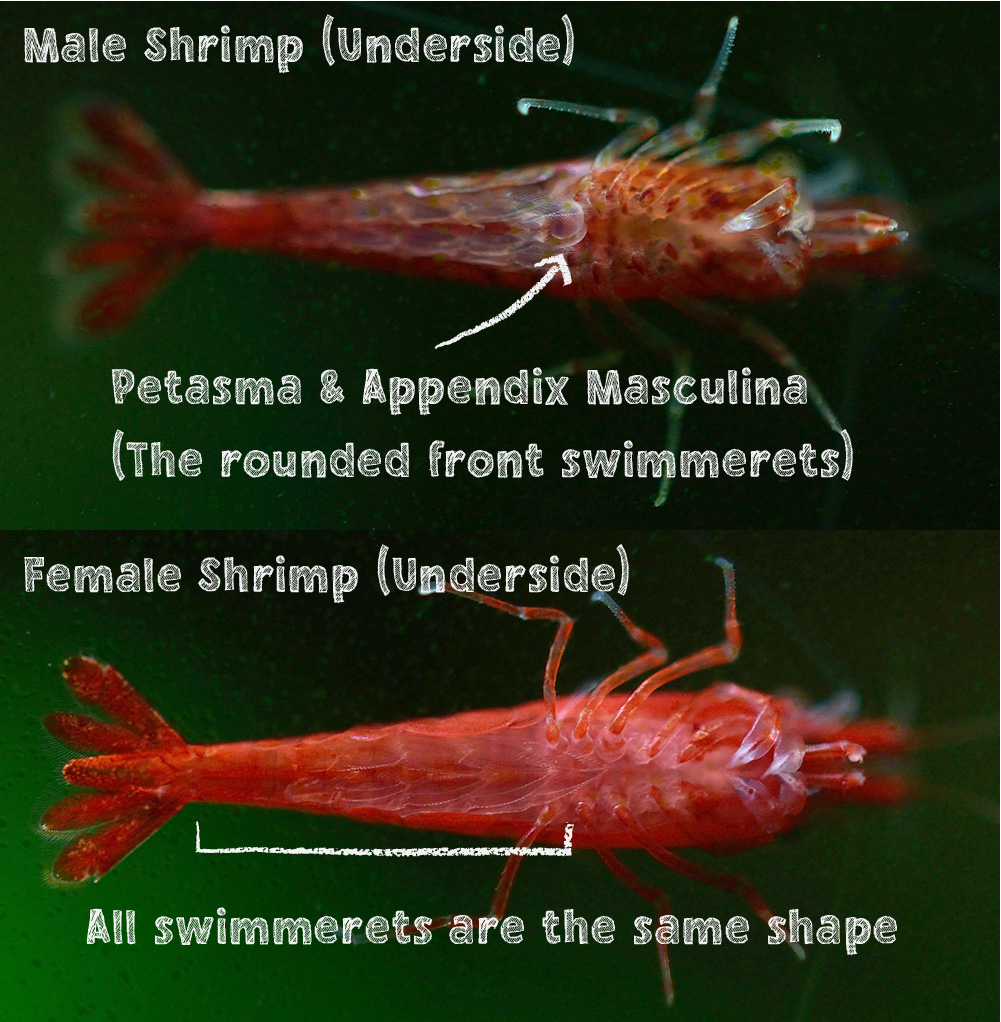
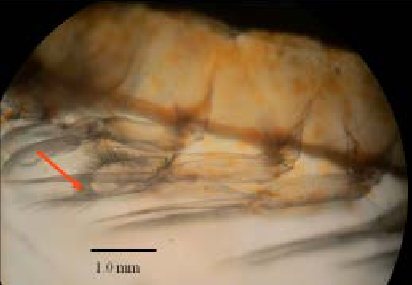 Neocaridina appendix masculina (arrow) - Image Source
Neocaridina appendix masculina (arrow) - Image SourceThe petasma and appendix masculina are appendages used during mating to help the male shrimp attach to the female in the proper position to give her the sperm packet. The petasma is located in front of the first pair of pleopods, while the appendix masculina is located in front of the second pair. These may be just barely visible on the underside of the males when they are up against the glass, but it takes an expert with great eyesight to tell without a microscope.
Welp, that's in for the differences in sex between dwarf shrimp! We hope this information helps you tell them apart so you can see cute little baby shrimp soon. If you don't see clear differences between your shrimp, then it's likely they are just too young so be patient.
If you have any questions or suggestions for how we can improve this lesson, please don't hesitate to reach out via email or social media. We love talking about all things shrimp!
To get new lesson notifications and receive other fun shrimp-related content, feel free to subscribe to our newsletter and follow us on social media.
Have a great day and happy shrimpin’!